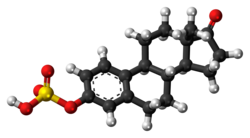Chemical compound From Wikipedia, the free encyclopedia
Estrone sulfate (E1S) is an estrogen medication and naturally occurring steroid hormone.[1] It is used in menopausal hormone therapy among other indications.[1][2] As the sodium salt (sodium estrone sulfate), it is the major estrogen component of conjugated estrogens (Premarin) and esterified estrogens (Estratab, Menest).[1][3] In addition, E1S is used on its own as the piperazine salt estropipate (piperazine estrone sulfate; Ogen).[1][3] The compound also occurs as a major and important metabolite of estradiol and estrone.[1] E1S is most commonly taken by mouth, but in the form of Premarin can also be taken by parenteral routes such as transdermal, vaginal, and injection.[1][2]
 | |
 | |
| Clinical data | |
|---|---|
| Other names | E1S; Oestrone sulfate; Estrone 3-sulfate; Estra-1,3,5(10)-trien-17-one 3-sulfate |
| Routes of administration | By mouth, others[1][2][3] |
| Drug class | Estrogen; Estrogen ester |
| Pharmacokinetic data | |
| Protein binding | 90%, to albumin, and not to SHBG[4] |
| Metabolism | Desulfation (via STS)[5] |
| Metabolites | • Estrone[1] • Estradiol[1] |
| Elimination half-life | 12 hours[6] |
| Identifiers | |
| |
| CAS Number |
|
| PubChem CID | |
| IUPHAR/BPS | |
| DrugBank | |
| ChemSpider | |
| UNII | |
| ChEBI | |
| ChEMBL | |
| Chemical and physical data | |
| Formula | C18H22O5S |
| Molar mass | 350.43 g·mol−1 |
| 3D model (JSmol) | |
| |
| |
| (verify) | |
E1S is used in menopausal hormone therapy among other indications.[1][2]
E1S itself is essentially biologically inactive, with less than 1% of the relative binding affinity of estradiol for the estrogen receptors (ERs), ERα and ERβ.[7] The compound acts as a prodrug of estrone and more importantly of estradiol, the latter of which is a potent agonist of the ERs.[1] Hence, E1S is an estrogen.[1]
E1S is cleaved by steroid sulfatase (also called estrogen sulfatase) into estrone.[5] Simultaneously, estrogen sulfotransferases transform estrone back into E1S, which results in an equilibrium between the two steroids in various tissues.[5] E1S is thought to serve both as a rapidly-acting prodrug of estradiol and also as a long-lasting reservoir of estradiol in the body, which serves to greatly extend the duration of estradiol when used as a medication.[1][8][9]
When estradiol is administered orally, it is subject to extensive first-pass metabolism (95%) in the intestines and liver.[10][11] A single administered dose of estradiol is absorbed 15% as estrone, 25% as E1S, 25% as estradiol glucuronide, and 25% as estrone glucuronide.[10] Formation of estrogen glucuronide conjugates is particularly important with oral estradiol as the percentage of estrogen glucuronide conjugates in circulation is much higher with oral ingestion than with parenteral estradiol.[10] Estrone glucuronide can be reconverted back into estradiol, and a large circulating pool of estrogen glucuronide and sulfate conjugates serves as a long-lasting reservoir of estradiol that effectively extends its terminal half-life of oral estradiol.[10][11] To demonstrate the importance of first-pass metabolism and the estrogen conjugate reservoir in the pharmacokinetics of estradiol,[10] the terminal half-life of oral estradiol is 13 to 20 hours[12] whereas with intravenous injection its terminal half-life is only about 1 to 2 hours.[13]
Estrogen sulfates like estrone sulfate are about twice as potent as the corresponding free estrogens in terms of estrogenic effect when given orally to rodents.[14] This in part led to the introduction of conjugated estrogens (Premarin), which are primarily estrone sulfate, in 1941.[14]
| Estrogen | HF | VE | UCa | FSH | LH | HDL-C | SHBG | CBG | AGT | Liver |
|---|---|---|---|---|---|---|---|---|---|---|
| Estradiol | 1.0 | 1.0 | 1.0 | 1.0 | 1.0 | 1.0 | 1.0 | 1.0 | 1.0 | 1.0 |
| Estrone | ? | ? | ? | 0.3 | 0.3 | ? | ? | ? | ? | ? |
| Estriol | 0.3 | 0.3 | 0.1 | 0.3 | 0.3 | 0.2 | ? | ? | ? | 0.67 |
| Estrone sulfate | ? | 0.9 | 0.9 | 0.8–0.9 | 0.9 | 0.5 | 0.9 | 0.5–0.7 | 1.4–1.5 | 0.56–1.7 |
| Conjugated estrogens | 1.2 | 1.5 | 2.0 | 1.1–1.3 | 1.0 | 1.5 | 3.0–3.2 | 1.3–1.5 | 5.0 | 1.3–4.5 |
| Equilin sulfate | ? | ? | 1.0 | ? | ? | 6.0 | 7.5 | 6.0 | 7.5 | ? |
| Ethinylestradiol | 120 | 150 | 400 | 60–150 | 100 | 400 | 500–600 | 500–600 | 350 | 2.9–5.0 |
| Diethylstilbestrol | ? | ? | ? | 2.9–3.4 | ? | ? | 26–28 | 25–37 | 20 | 5.7–7.5 |
Sources and footnotes
Notes: Values are ratios, with estradiol as standard (i.e., 1.0). Abbreviations: HF = Clinical relief of hot flashes. VE = Increased proliferation of vaginal epithelium. UCa = Decrease in UCa. FSH = Suppression of FSH levels. LH = Suppression of LH levels. HDL-C, SHBG, CBG, and AGT = Increase in the serum levels of these liver proteins. Liver = Ratio of liver estrogenic effects to general/systemic estrogenic effects (hot flashes/gonadotropins). Sources: See template. | ||||||||||
Metabolic pathways of estradiol in humans
|
E1S, also known as estrone 3-sulfate or as estra-1,3,5(10)-trien-17-one 3-sulfate, is a naturally occurring estrane steroid and a derivative of estrone.[15] It is an estrogen conjugate or ester, and is specifically the C3 sulfate ester of estrone.[15] Salts of E1S include sodium estrone sulfate and estropipate (piperazine estrone sulfate).[15][1][3]
Seamless Wikipedia browsing. On steroids.